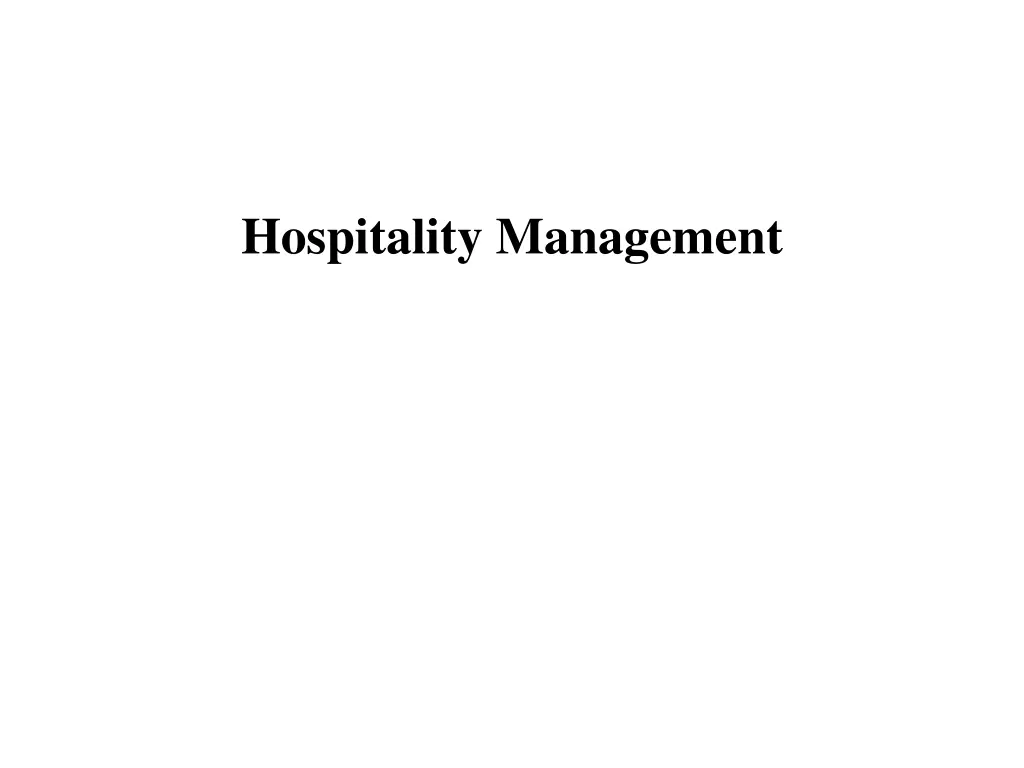
Understanding Hospitality and Tourism Industry
"Explore the world of hospitality management, the objectives of the hospitality industry, and the components of hospitality services. Discover the scope and types of establishments in this dynamic sector."
Download Presentation

Please find below an Image/Link to download the presentation.
The content on the website is provided AS IS for your information and personal use only. It may not be sold, licensed, or shared on other websites without obtaining consent from the author. If you encounter any issues during the download, it is possible that the publisher has removed the file from their server.
You are allowed to download the files provided on this website for personal or commercial use, subject to the condition that they are used lawfully. All files are the property of their respective owners.
The content on the website is provided AS IS for your information and personal use only. It may not be sold, licensed, or shared on other websites without obtaining consent from the author.
E N D
Presentation Transcript
Hospitality Hospitality is the relationship between guest and host, or the act or practice of being hospitable. Specifically, this includes the reception and entertainment of guests, visitors, or strangers, resorts, membership clubs, conventions, attractions, special events, and other services for travellers and tourists. "Hospitality" can also mean generously providing care and kindness to whoever is in need.
Objectives of Hospitality Understand the hospitality industry Understand the national and international employment opportunities available in the hospitality industry The industry employs 2 million people The restaurant industry is the largest in terms of jobs, employing half a million people The industry employs a young workforce just over a third of the staff are under 25
Hospitality and Tourism Largest and fastest growing industries Common dynamics: Delivery of services and products Customer and guest impressions are critical
Scope of Hospitality and Tourism Industry Travel Air Cruise Rail Coach Auto Ecotourism Lodging Hotels Motels Meetings, Conventions, and Expositions Restaurants Managed services Recreation Attractions Gaming Parks Recreation
Components of Hospitality Industry 1. Lodging Operations -such as hotels, resorts, motels etc. 2. Transportation Services -such as taxi, train, cruise ships, etc. 3. Food and Beverage Operations -such as restaurants, bars, etc. 4. Retail Stores -such as souvenir shops, etc. 5. Activities -such as recreations, festivals, etc.
Types in hospitality industry NATIONAL All the outlets look the same, with the same style of furnishing, menus and pricing. LOCAL One can find a wide variety of specialised and interesting menus, accommodation and prices.
Overview of Hospitality Industry Characteristics of Hospitality Industry 1. Inseparability 2. Perishability 3. Labor-intensive 4. Repetitive 5. Intangibility
Characteristic of Services Characteristic Description 1) Intangibility Service products cannot be tasted, felt, seen, heard, or smelled. Prior to boarding a plane, airline passengers have nothing but an airline ticket and a promise of safe delivery to their destination. To reduce uncertainty caused by service intangibility, buyers look for tangible evidence that will provide information and confidence about the service. 2) Inseparability For many services, the product cannot be created or delivered without the customer s presence. The food in a restaurant may be outstanding, but if the server has a poor attitude or provides inattentive service, customers will not enjoy the overall restaurant experience. In the same way, other customers can affect the experience in service settings. 3) Heterogeneity Service delivery quality depends on who provides the services. The same person can deliver differing levels of service, displaying a marked difference in tolerance and friendliness as the day wears on. Lack of consistency is a major factor in customer dissatisfaction. 4) Perishability Services cannot be stored. Empty airline seats, hotel rooms, daily ski passes, restaurant covers all these services cannot be sold the next day. If services are to maximize revenue, they must manage capacity and demand since they cannot carry forward unsold inventory.
Characteristics of the Hospitality Industry Product is intangible and perishable No such thing as business hours Hospitality operations run on a 24-hour basis all year round Characterized by shift work
Corporate Philosophy Philosophy: Shift toward greater employee empowerment Strong links to TQM Service philosophy is a way of life
Corporate Culture Culture: Overall style and feel of the company Mission statement: Central purposes, strategies, and values
Corporate Culture (cont.) Goal: Broad statement geared toward accomplishment Strategy/tactics: Actions needed to reach goals
According to Levels of Service a. World-Class Service b. Medium-Range Service c. Economy / Limited Service
The hospitality industry consists of broad category of fields within the service industry that includes lodging, restaurants, event planning, theme parks, transportation, cruise line, and additional fields within the tourism industry. The hospitality industry is a several billion dollar industry that mostly depends on the availability of leisure time and disposable income. A hospitality unit such as a restaurant, hotel, or even an amusement park consists of multiple groups such as facility maintenance, direct operations (servers, housekeepers, porters, kitchen workers, bartenders, etc.), management, marketing, and human resources.
Sectors in hospitality industry COMMERCIAL SECTOR It includes any businesses where the sale of food and drink or accommodation is the main source of income. The commercial sector includes hotels, restaurants and clubs etc. CATERING SERVICES SECTOR It includes situations where food and drink services are provided within other organisations whose main focus is not hospitality.
Front-of-the-house vs. Back-of-the-house Front-of-the-house : areas that involves guest and employee interaction (front office, restaurants, and lounges). Back-of-the-house : areas where interaction between guests and employees is less common (housekeeping, engineering and maintenance, accounting, and human resources).
For Success in Service We Need to: Focus on the guest Understand the role of the guest-contact employee Weave a service culture into education and training systems Thrive on change
Thank You..! Thank You..!
